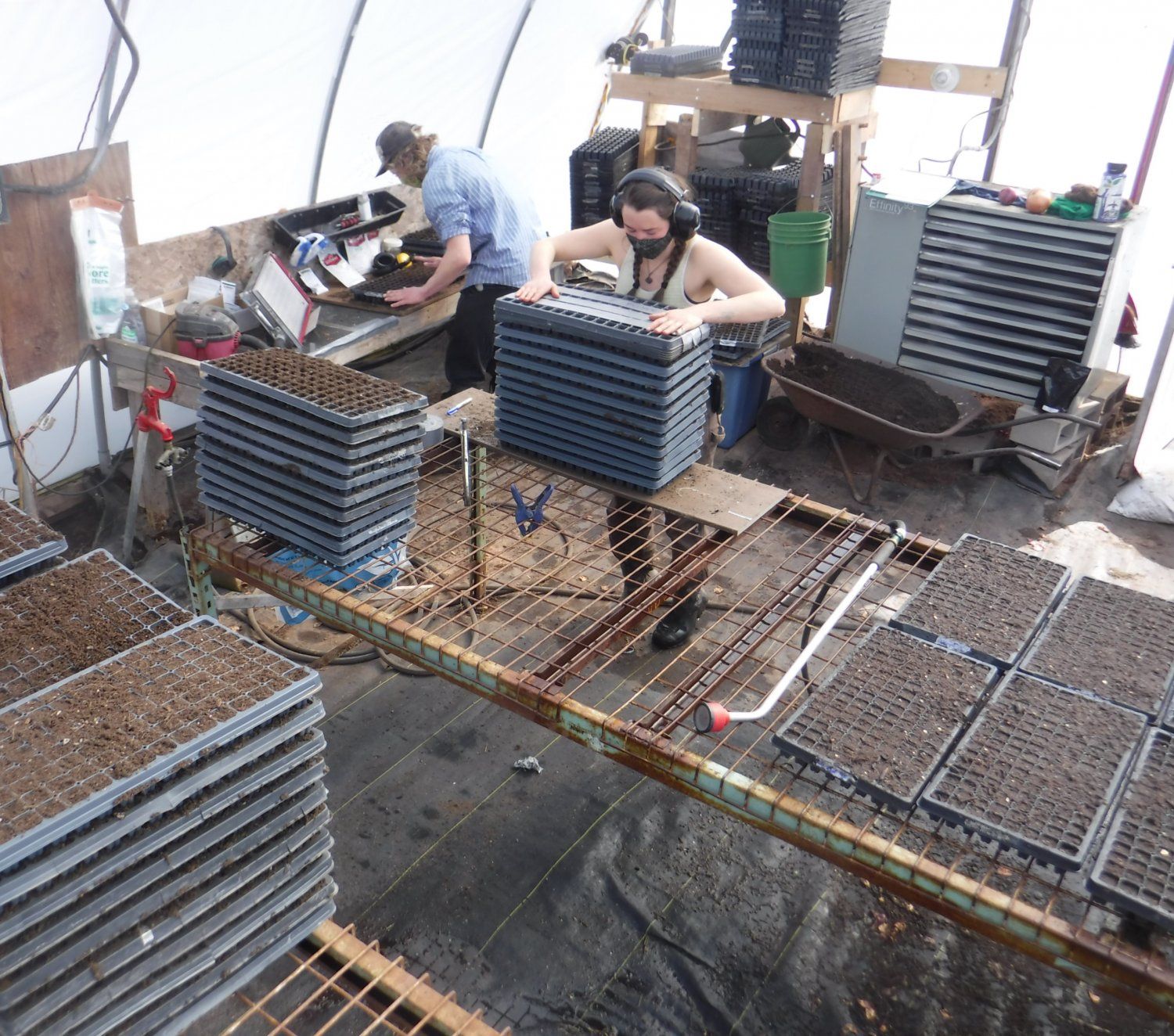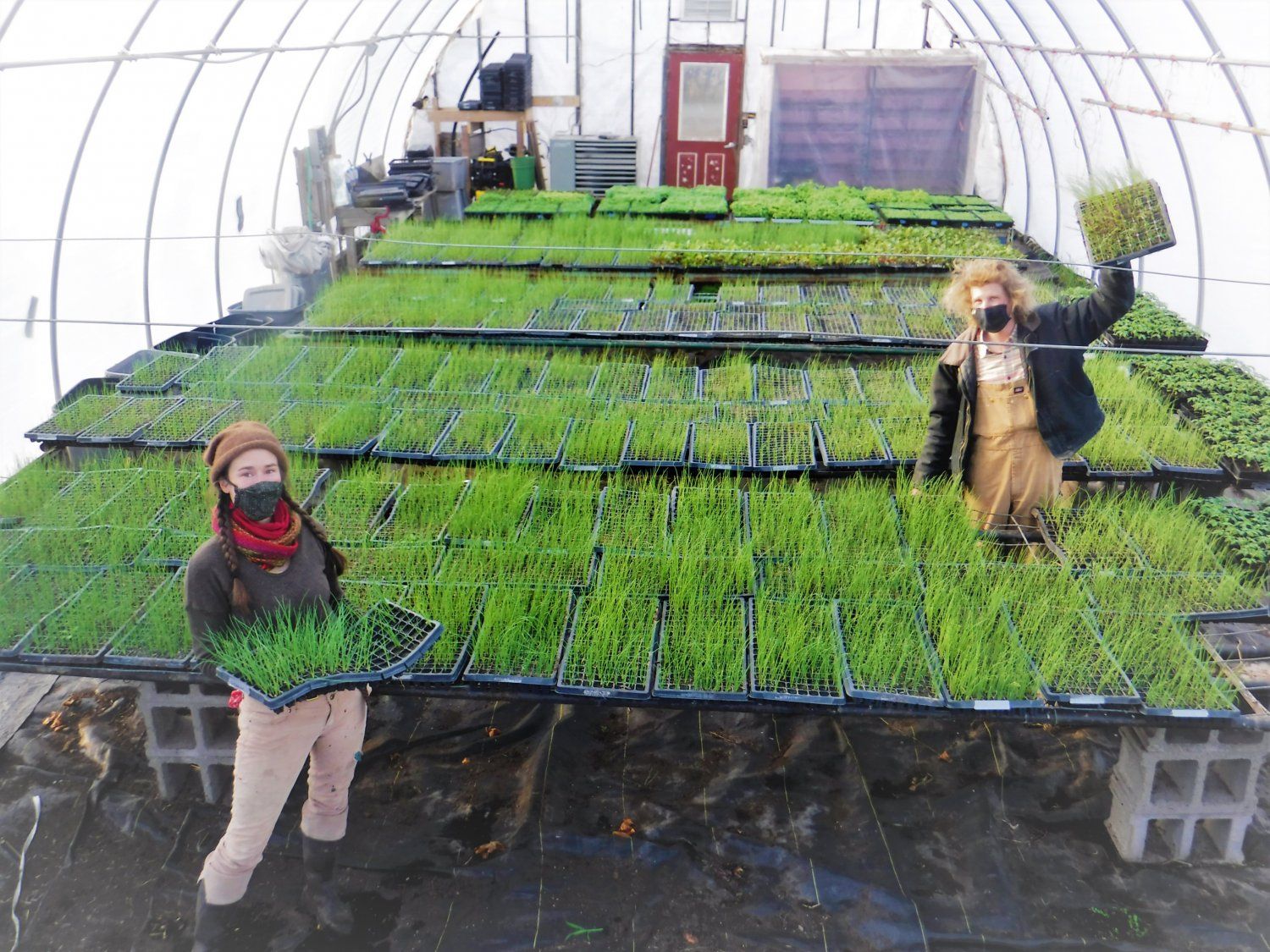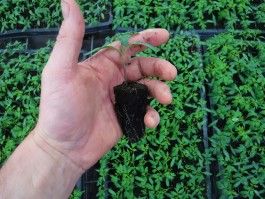Spring has sprung! Round 2 of mud season comes along in full force as well, but that's to be expected. Not necessarily appreciated (especially when living on a dirt road, with a gravel driveway) but we need the moisture this year, and it's just part of the living where we do. When we built our house, we decided to keep the downstairs floor concrete, which makes for easy cleanup with a house full of kids, farm boots, and critters. Thankfully our farm dog Buster is thoughtful, and does his best to keep the floor clean. Whenever he comes inside during muddy seasons, he immediately rolls over on his back and waits for us to wipe off his feet with an old towel! Border collies are some awfully smart dogs. While we are not raising sheep any more, we still appreciate his clever thinking.
The greenhouse is jam packed with starts, some growing up for another 2 weeks until they start to hit fresh dirt in our hoophouses, others waiting patiently until fields can be prepped for outside planting. There's something reassuring about walking into a bright, warm, green place while the world outside is still on the fence about whether it's winter or spring yet. The first chore here every morning is heading into the greenhouse to water. Seeing those racks of cheery onion tops in spite of the fresh cover of snow on the ground outside is an uplifting way to start the day!
Other crops are growing fast as well now. The tomatoes and peppers will likely be "potted up" into larger 4" pots next week (that's a tomato seedling in the picture below.) This helps give the plants a little more space for their leaves to expand (think solar panels!) and lets their roots develop for 3 more weeks or so before they get transplanted into hoophouses. Most of the time, we judge a plant by what we can see above ground. But on most plants, the mass below ground - the many fibers of the root system - are usually much larger than what we can see up top. Giving that little seedling room to stretch out and make a large root system is critical to successful transplant production. Leaving a transplant in a small cell for too long can make a transplant look really big on top, but results in the plant getting "root bound," where the roots get so packed in to the soil of a cell they have a hard time stretching out again once the seedling is transplanted outside or into a larger container. The plant can be stressed for weeks after transplanting and might not be able to grow to it's full potential even after it recovers.
Big root systems help plants with nutrient access by providing a habitat for symbiotic fungi and bacterial microorganisms in the soil. These little microorganisms latch on to the roots of the plants and strike up all kinds of underground "trades." The plant usually supplies the microorganism with sugar as a byproduct of photosynthesis, and the microorganisms break down soil-bound micro and macro nutrients into a form that is easy for the plant to uptake. Symbiotic relationships like these - totally invisible to our naked eye - are the currency that makes the plant world go round. But these relationships get even more interesting. Many microorganisms will be able to understand when the plant is fighting infection or stressed in some way. Microorganisms can actually organize to help their host plant stay alive, sending missing nutrients to boost plant immunity, or actively fight off destructive fungal or bacterial pathogens in the soil! This is why supporting soil health is crucial in organic farming systems, and why we spend so much time and money on applying compost and growing cover crops to support these little "good critters" that we can't even see. We actually inoculate every flat we seed in the greenhouse with little good bacteria, so that they can begin colonizing the roots of the plants right away from day 1. They come in a fine powder that we apply with a spice shaker over the top of each flat as soon as it is seeded. Those little soil micros might be the most important livestock on the farm!
Microgreen production is still in full swing, and we are planning to have them available all year long now. I am so glad everyone has been enjoying them! If you appreciate food with a little kick, we've added a nice purple radish to our radish mix now to brighten up the radish micros and get more variety in flavor and nutrition. Darker colored plants are typically rich in anthocyanins. Anthocyanins have both anti-inflammatory and anti-bacterial properties, and can help lower blood pressure, improve eyesight, reduce cancer cell proliferation, inhibit tumor formation, and even help prevent diabetes. We really like those radish micros with an egg and a side of kraut or kim chi for breakfast. Also on the spicy news front, the mustard mix that we grew out 2 weeks ago was a smashing hit. We have more seeds and are planning to have this be a regularly available product, but right now we're outta space in our microgreen room (and they are already overflowing into the greenhouse!) As soon as we are able to find some more room we'll get that back on the menu. In the mean time, we're working on a label so that is ready to go when we're ready to grow.
If spicy stuff isn't your cuppa tea, don't worry, we've got plenty of other healthy options. Red cabbage micros are loaded with nutrition in the form of anthocyanins and another compound found in broccoli family plants called sulforaphane (they are one of the most nutrient dense foods you can eat!) The highest concentration of this compound is in broccoli itself, but all brassica family plants (like kale, cabbage, broccoli, and kohlrabi, which all happen to be in our mild microgreen mix) whether grown as micros or to full size have sulforaphane. Broccoli micros are especially loaded, and can have up to 10x as much of this compound as mature broccoli, ounce for ounce. You can look up the many benefits of this sulforaphane compound - it's impressive stuff, with a resume that includes cancer fighting properties and so much more.
Leave it up to the nutrition scientists to figure out the details, but I think we all understand that real food, good healthy food, is medicine. Author Michael Pollen summed it up pretty well in his 2006 book The Omnivore's Dilemma: "Eat food. Not too much. Mostly plants."
In the hoophouses, spinach is back in full swing now that the days are getting longer and warmer. Spinach absolutely loves this weather. Warm sunny days make it grow, cold days make it sweet. You can't go wrong!
I have been growing food for a while now, but every year I continue to be amazed at the variety of local foods available throughout the seasons here in the Northwoods. It's a pretty special place for a lot of reasons, but that one really sticks with me. I was recently listening to a Winter Grower's podcast, which featured a farm from North Carolina. Do they even have winter down there?? Winter growing and season extension takes extra work, and requires a thoughtful approach to both production and deciding what's for dinner each night. Thanks to each of you for making the conscious effort to include local foods in your meals!
On that note, here's a message from Farmer Brian of Northcroft Farm, and a few recipe suggestions you might find helpful.
Welcome to spring everyone, our regular season shares are over until June but I hope you all take advantage of the weekly farmstand boxes we will be offering for the next two months. With the farmstand boxes you can fill your box with anything we have available from meat to veggies all in one box. For this delivery we are highlighting a few items for the Easter Holiday including hams and lamb roast from Heritage Acres. Below you will find a few special Easter recipes including a Greek Lamb Roast, Glazed Honey Carrots, and a Spinach and Egg Pie.
In addition to the farmstand boxes we have a couple smaller mini-shares available over the next couple months including the Spring Tulip share from Wild Hollow Farm and Perennial Plant Boxes from Hauser's Superior View Farm. For the summer Starlit Kitchen has also just launched a new "Sweets Box".
Thank you all for a great winter. With the ice receding and the temperatures warming everyone at Bayfield Foods is getting ready for a busy season. We look forward to providing great food for you and your families this year and we hope you are getting outside and enjoying the warmer weather.
Greek lamb roast
4# lamb roast
8 garlic cloves - 2 cut into thin slices the other 6 crushed and chopped.
3 tablespoons fresh rosemary chopped
3 teaspoons dried oregano
½ tablespoons salt
1 tablespoon black pepper
3 tablespoons olive oil
2 lemons
1. In a bowl, make a marinade by combining the crushed garlic, chopped rosemary, sea salt, pepper, olive oil and lemon juice.
2. Make 4 slits about 1 inch (3 cm) deep in the lamb leg. Push half a clove of garlic and a small sprig of rosemary deep into the slit. Place the lamb in a dish or plastic bag, rub the marinade over all of the lamb and then cover the dish and refrigerate 12-18 hours
3. Oven options: About 45 minutes before cooking, bring the lamb to room temperature. Pre-heat your oven to 350 f (180 c). Place the lamb in the oven and roast for 1 hour 40 minutes. Ovens vary so check the internal temperature of the lamb about 10 minutes before it is due to be removed. Remove the lamb when the temperature registers about 140 f (60 c). Loosely cover the lamb in aluminum foil. The lamb will continue to cook for a short time and should result in a medium rare to medium done roast.
Crock Pot option: place roast in your crock pot on low for 4-5 hours.
· Other options to consider, I added a ½ cup of white wine to the crock pot for some extra flavor as well as 1 large onion chopped.
Egg and Spinach Pie
This egg and spinach pie is fantastic but it’s a little more in-depth on instruction so I am going to just provide a link to this one.
https://cnz.to/recipes/vegetables-grains/french-easter-pie-spinach-goat-cheese-recipe/
Honey Glazed Carrots
· 1 pound carrots, peeled and coined or sliced at an angle, 1/4-inch thick
· ½ cup chicken broth
· 1 tbsp plus 2 tablespoons honey
· 1 tbsp butter
· ½ tsp thyme
· 2 tsp lemon juice
· Black pepper as desired
INSTRUCTIONS
1. Place carrots, broth, 1 tablespoon honey, and salt in an approximately 12-inch skillet set over medium-high heat and bring to a boil. Reduce heat to medium, cover, and simmer for 5 minutes, stirring occasionally. Carrots should be tender when poked with a fork.
2. Uncover pan and turn the heat up a bit. Stir for 1 to 2 minutes or until liquid is reduced to a couple of tablespoons.
3. Add the butter,2 tablespoons of honey, and thyme to skillet, mixing until butter is melted and carrots are evenly coated. Cook for a couple more minutes, stirring frequently, until carrots are completely tender and glaze has thickened and turned golden.
4. Remove skillet from heat, stir in lemon juice, and season with pepper.
Thanks again for making us your farmers!
In community,
Farmer Chris
Great Oak Farm

.JPG)
.JPG)
.JPG)
.JPG)

.JPG)



